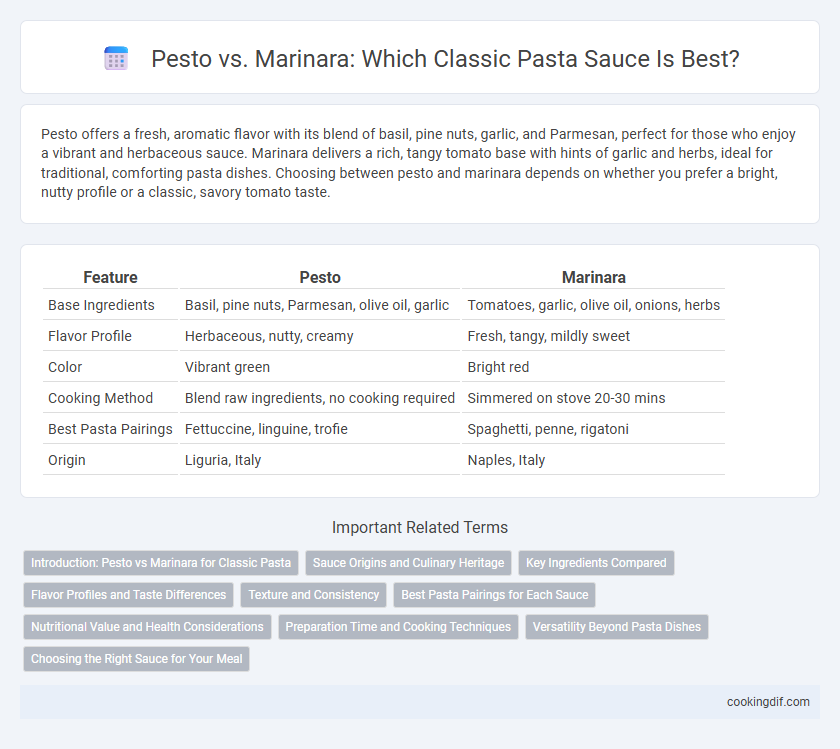Pesto offers a fresh, aromatic flavor with its blend of basil, pine nuts, garlic, and Parmesan, perfect for those who enjoy a vibrant and herbaceous sauce. Marinara delivers a rich, tangy tomato base with hints of garlic and herbs, ideal for traditional, comforting pasta dishes. Choosing between pesto and marinara depends on whether you prefer a bright, nutty profile or a classic, savory tomato taste.
Table of Comparison
| Feature | Pesto | Marinara |
|---|---|---|
| Base Ingredients | Basil, pine nuts, Parmesan, olive oil, garlic | Tomatoes, garlic, olive oil, onions, herbs |
| Flavor Profile | Herbaceous, nutty, creamy | Fresh, tangy, mildly sweet |
| Color | Vibrant green | Bright red |
| Cooking Method | Blend raw ingredients, no cooking required | Simmered on stove 20-30 mins |
| Best Pasta Pairings | Fettuccine, linguine, trofie | Spaghetti, penne, rigatoni |
| Origin | Liguria, Italy | Naples, Italy |
Introduction: Pesto vs Marinara for Classic Pasta
Pesto and marinara represent two iconic sauces in classic pasta dishes, each offering distinct flavor profiles rooted in Italian culinary tradition. Pesto features a rich blend of fresh basil, pine nuts, garlic, Parmesan cheese, and olive oil, delivering a vibrant, herbaceous taste ideal for lighter pasta varieties like linguine and trofie. Marinara, a tomato-based sauce infused with garlic, onions, and herbs such as basil and oregano, provides a robust, tangy flavor that complements heartier pasta types like spaghetti and penne.
Sauce Origins and Culinary Heritage
Pesto sauce originates from Liguria, Italy, characterized by fresh basil, pine nuts, garlic, Parmesan cheese, and olive oil, reflecting the region's Mediterranean culinary heritage. Marinara sauce, rooted in Southern Italian cuisine, combines tomatoes, garlic, onions, and herbs, representing the Neapolitan tradition and the introduction of New World tomatoes in the 16th century. Both sauces encapsulate distinct regional flavors and histories that have shaped classic Italian pasta dishes worldwide.
Key Ingredients Compared
Pesto features fresh basil, pine nuts, garlic, Parmesan cheese, and olive oil, creating a rich, herbaceous flavor profile, while marinara relies on tomatoes, garlic, onions, olive oil, and herbs like basil or oregano for a bright, tangy taste. The primary difference lies in pesto's emphasis on fresh herbs and nuts versus marinara's tomato base, impacting texture and nutritional content. Selecting between the two sauces depends on preference for a creamy, nutty consistency or a light, tomato-forward sauce in classic pasta dishes.
Flavor Profiles and Taste Differences
Pesto offers a vibrant herbal flavor profile characterized by fresh basil, garlic, pine nuts, and Parmesan, delivering a rich, nutty, and aromatic taste. Marinara features a savory and slightly tangy profile, highlighting ripe tomatoes, garlic, onions, and Italian herbs, creating a bright and robust flavor. The contrast between pesto's creamy, herbaceous complexity and marinara's hearty, tangy simplicity defines their distinct appeal in classic pasta dishes.
Texture and Consistency
Pesto sauce offers a rich, creamy texture with a slightly coarse consistency due to crushed basil leaves, pine nuts, and Parmesan cheese blending into olive oil. Marinara presents a smoother, more liquid consistency, featuring a thin, tomato-based sauce with chunks of cooked tomatoes, garlic, and herbs. Texturally, pesto is thicker and more robust, while marinara is lighter and more fluid, complementing different pasta types and culinary preferences.
Best Pasta Pairings for Each Sauce
Pesto's rich basil, garlic, and pine nut blend pairs excellently with pasta shapes like trofie, linguine, and fettuccine, which effectively trap the sauce's vibrant texture. Marinara sauce, characterized by its bright tomato base, garlic, and herbs, complements long strands like spaghetti and bucatini or hearty tubes such as rigatoni, balancing acidity with pasta's surface area. Choosing the right pasta shape enhances the harmony of flavors and mouthfeel, highlighting pesto's freshness or marinara's robust tanginess.
Nutritional Value and Health Considerations
Pesto sauce, made from fresh basil, pine nuts, olive oil, and Parmesan cheese, offers healthy fats, antioxidants, and vitamins A and K, supporting heart health and anti-inflammatory benefits. Marinara sauce, primarily tomato-based with garlic and herbs, is rich in vitamin C, lycopene, and low in calories, promoting immune health and reduced inflammation. Choosing between pesto and marinara depends on dietary goals: pesto provides healthy fats and protein, while marinara is lower in calories and carbohydrates, suitable for weight management.
Preparation Time and Cooking Techniques
Pesto sauce, made from fresh basil, pine nuts, Parmesan, garlic, and olive oil, requires minimal preparation time as it involves no cooking, just blending or pounding ingredients. Marinara sauce, a traditional tomato-based sauce, demands longer preparation and cooking, involving sauteing garlic and onions, simmering tomatoes, and seasoning to develop deep flavors. Choosing pesto saves time with its fresh, raw preparation, while marinara's slow simmering enhances complexity through heat and blending of ingredients.
Versatility Beyond Pasta Dishes
Pesto offers vibrant, herbal notes that complement not only pasta but also grilled meats, roasted vegetables, and sandwiches, showcasing its adaptability in diverse culinary applications. Marinara, with its rich tomato base and savory garlic flavors, serves as a foundational sauce ideal for dipping, baking in casseroles, and enhancing seafood dishes. Both sauces extend beyond traditional pasta pairings, providing versatile options that elevate a wide range of meals with distinctive regional tastes.
Choosing the Right Sauce for Your Meal
Pesto, made from fresh basil, pine nuts, garlic, Parmesan cheese, and olive oil, offers a vibrant, herbaceous flavor that pairs well with lighter pasta dishes like angel hair or linguine. Marinara, a tomato-based sauce rich in garlic, onions, and herbs, provides a robust, tangy profile ideal for heartier pasta such as spaghetti or penne. Selecting the right sauce depends on the desired taste intensity and the pasta's ability to hold and complement the sauce's texture and flavor.
Pesto vs marinara for classic sauce Infographic

 cookingdif.com
cookingdif.com